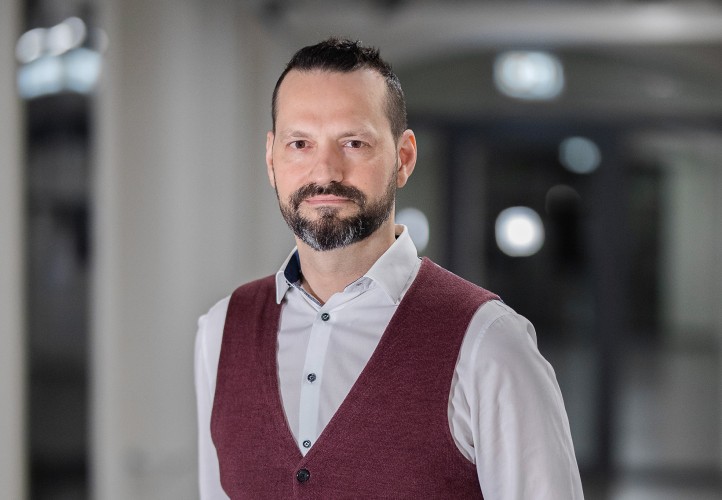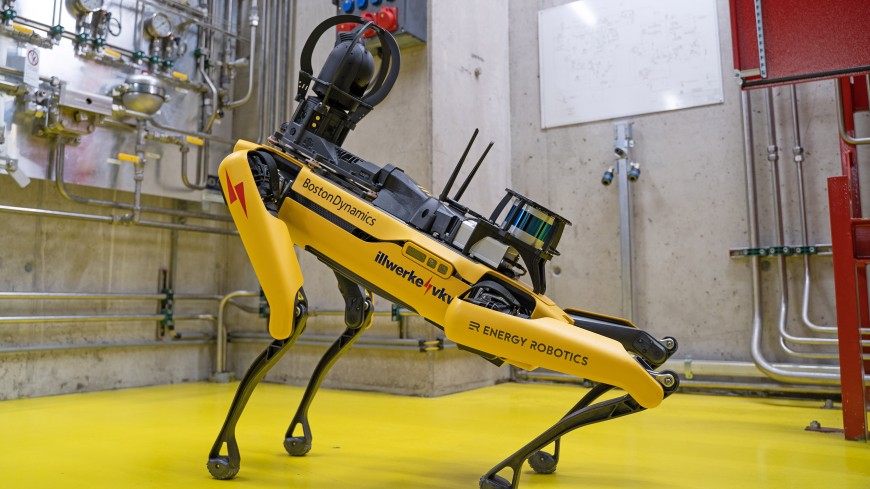Robot brain on patrol
Start-up Energy Robotics solves sensitive monitoring tasks worldwide
2022/03/15 by Astrid Ludwig
In March 2019, former doctoral students at the Technical University of Darmstadt Alberto Romay, Stefan Kohlbrecher, Dorian Scholz and TU alumnus Marc Dassler founded the company “Energy Robotics GmbH” together with Professor Oskar von Stryk. Today, just three years later, the team with its software for autonomous inspection robots is a global leader in the market for monitoring oil, gas or chemical plants. Energy Robotics' software is already being successfully used on a continuous basis in 13 countries on four continents and the TU spin-off is continuing to expand.
As nimble as a dog, the robot climbs up and down stairs, runs across corridors and platforms, past huge pipelines, conduit systems, turbines and equipment inside a hydroelectric power plant in the Austrian Alps. With its elongated yellow body on slender black legs, the inspection robot really does look like a dog on watchful patrol of its territory. The camera system in the robot's head scans the environment, continuously looking for possible malfunctions, objects that do not belong there, unusual processes, and checks temperature data and control gauges.
Marc Dassler,
CEO Energy Robotics
We are the world's software experts for inspection robots and also have most of them permanently in use.

The walking robot was built by the company Boston Dynamics. The hardware is the shell, the inner workings were designed by the Darmstadt start-up Energy Robotics. The computer science graduates of the Technical University and the US robotics company have been working together since 2021. “We develop the software for the inspection robots”, explains Energy Robotics CEO Marc Dassler. Since 2019, the TU spin-off offers the first commercially available software platform that combines a hardware-independent robot operating system with cloud-based fleet management and AI-driven data analysis for industrial applications.
Energy Robotics specialises in the oil, gas, chemical and energy industries. The team's developments are designed for monitoring on oil and gas platforms, chemical plants, but also in substations and power plants. Customers include companies such as Shell, Woodside, Merck, BASF, BP, Eon and Evonik. “We are the world's software experts for inspection robots and also have most of them permanently in use”, says CEO Dassler.
Strong growth thanks to excellent support
A successful company history: Supported since 2017 by the TU Innovation and Start-up Centre HIGHEST, Energy Robotics was named Start-up of the Year by “Frankfurt Forward” in November 2021. “Frankfurt Forward” brings together founders and established companies under the umbrella of the Frankfurt Economic Development GmbH. In early 2021, Earlybird Venture Capital and other investors had already invested around two million euros in the Darmstadt-based developers, and the search for further investors is currently underway. “We have grown strongly since then”, says Marc Dassler. In just three years, the number of employees at the TU spin-off has risen to 28. Energy Robotics' software solutions are now in use in 13 countries on four continents.
The company is based at Hub31, in Hilpertstrasse in Darmstadt. “The new laboratory and robot testing facility are located there”, reports TU professor Oskar von Stryk. A small part of the team is working and developing locally, but most of the staff are spread across Germany and Europe, says CEO Dassler.
We all have our roots in university robot football
Dr Stefan Kohlbrecher
The start-up was created at the Department of Computer Science at the TU Darmstadt. The members of the founding team have known each other for more than ten years. “We all have our roots in university robot football”, recounts Stefan Kohlbrecher. He and Dorian Scholz were initially undergraduate students and later doctoral students of Professor von Stryk. They were joined by the Mexican Alberto Romay when international university teams came together at the RoboCup, the Robot Football World Championship in Graz 2009, and the TU Darmstadt dominated the scene. “I absolutely have to go there”, Romay thought and moved from Mexico City to Darmstadt with a doctoral scholarship.
One of the initial catalysts was the victory in the ARGOS Challenge of the French oil company Total, which involved the use of autonomous robots on gas and oil platforms. With its prototype, the TU team survived a three-year championship with competition rounds and missions lasting several weeks. “At that point it became clear to us: There is a market for our technology", recalls Professor von Stryk. The idea for the spin-off was born.
The robot records everything it sees and the client can give it tasks and specify what it should check during its tour.
Marc Dassler
Since then, Energy Robotics has continuously developed its cross-hardware software solutions. The robots of their company partners “Ex-Robotics” and Boston Dynamics – an application for other robot types and also drones is currently in the works – navigate autonomously thanks to the software from Darmstadt. Laser scanners are used to create maps of the facilities to be monitored. The robots learn. Once remotely sent on their surveillance course, they can then negotiate it on their own.
Innovative “Click-and-Inspect Technology”
The researching company members have developed a “click-and-inspect technology”. “The robot records everything it sees and the client can give it tasks and specify what it should check during its patrol”, explains Dassler. All this requires is a web browser. “We have constructed a kind of robot brain”, says the CEO. With the help of the camera, the robot collects data that it sends to this cloud brain. There, the desired information, such as the temperature of the pumps, pressure gauges, ball bearings or cooling systems, is extracted from the raw data and then forwarded to the client – with a special data security software, stresses the TU alumnus.
The market for the business idea of autonomous monitoring of industrial plants is growing worldwide. Drivers are digitalisation, but also demographic change and the growing shortage of skilled workers. Monitoring routines are time-consuming and costly. “Our software doesn't take away anyone's job”, says Marc Dassler. Companies prefer to deploy their scarce highly qualified staff in other areas instead of sending them on time-consuming patrols.
Supported by HIGHEST, the Innovation and Start-up Centre of the TU Darmstadt
08/2018 – 07/2020: – EXIST research transfer funding
2018 / 2019: Participation in the Start-up & Innovation Day
2017 – 2019: Initial consultation, pitch training, funding advice, research transfer application









